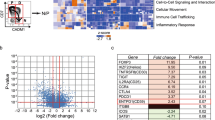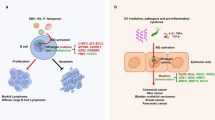Abstract
At sites of inflammation and tumor growth, the local concentration of extracellular adenosine rapidly increases and plays a role in controlling the immune responses of nearby cells. Adenosine deaminases ADA1 and ADA2 (ADAs) decrease the level of adenosine by converting it to inosine, which serves as a negative feedback mechanism. Mutations in the genes encoding ADAs lead to impaired immune function, which suggests a crucial role for ADAs in immune system regulation. It is not clear why humans and other mammals possess two enzymes with adenosine deaminase activity. Here, we found that ADA2 binds to neutrophils, monocytes, NK cells and B cells that do not express CD26, a receptor for ADA1. Moreover, the analysis of CD4+ T-cell subset revealed that ADA2 specifically binds to regulatory T cells expressing CD39 and lacking the receptor for ADA1. Also, it was found that ADA1 binds to CD16− monocytes, while CD16+ monocytes preferably bind ADA2. A study of the blood samples from ADA2-deficient patients showed a dramatic reduction in the number of lymphocyte subsets and an increased concentration of TNF-α in plasma. Our results suggest the existence of a new mechanism, where the activation and survival of immune cells is regulated through the activities of ADA2 or ADA1 anchored to the cell surface.







Similar content being viewed by others
References
Hasko G, Linden J, Cronstein B, Pacher P (2008) Adenosine receptors: therapeutic aspects for inflammatory and immune diseases. Nat Rev Drug Discov 7(9):759–770. doi:10.1038/nrd2638
Fredholm BB (2007) Adenosine, an endogenous distress signal, modulates tissue damage and repair. Cell Death Differ 14(7):1315–1323. doi:10.1038/sj.cdd.4402132
Linden J, Cekic C (2013) Regulation of lymphocyte function by adenosine. Arterioscler Thromb Vasc Biol 32(9):2097–2103. doi:10.1161/ATVBAHA.111.226837
Eltzschig HK, Sitkovsky MV, Robson SC (2012) Purinergic signaling during inflammation. N Engl J Med 367(24):2322–2333. doi:10.1056/NEJMra1205750
Burnstock G (2008) Purinergic signalling and disorders of the central nervous system. Nat Rev Drug Discov 7(7):575–590. doi:10.1038/nrd2605
Jacobson KA, Gao ZG (2006) Adenosine receptors as therapeutic targets. Nat Rev Drug Discov 5(3):247–264. doi:10.1038/nrd1983
Franco R, Pacheco R, Gatell JM, Gallart T, Lluis C (2007) Enzymatic and extraenzymatic role of adenosine deaminase 1 in T-cell-dendritic cell contacts and in alterations of the immune function. Crit Rev Immunol 27(6):495–509
Zavialov AV, Gracia E, Glaichenhaus N, Franco R, Lauvau G (2010) Human adenosine deaminase 2 induces differentiation of monocytes into macrophages and stimulates proliferation of T helper cells and macrophages. J Leukoc Biol 88(2):279–290. doi:10.1189/jlb.1109764
Buckley RH (2004) Molecular defects in human severe combined immunodeficiency and approaches to immune reconstitution. Annu Rev Immunol 22:625–655
Pacheco R, Martinez-Navio JM, Lejeune M, Climent N, Oliva H, Gatell JM, Gallart T, Mallol J, Lluis C, Franco R (2005) CD26, adenosine deaminase, and adenosine receptors mediate costimulatory signals in the immunological synapse. Proc Natl Acad Sci USA 102(27):9583–9588. doi:10.1073/pnas.0501050102
Mandapathil M, Hilldorfer B, Szczepanski MJ, Czystowska M, Szajnik M, Ren J, Lang S, Jackson EK, Gorelik E, Whiteside TL (2010) Generation and accumulation of immunosuppressive adenosine by human CD4+ CD25 high FOXP3+ regulatory T cells. J Biol Chem 285(10):7176–7186. doi:10.1074/jbc.M109.047423
Mandapathil M, Szczepanski M, Harasymczuk M, Ren J, Cheng D, Jackson EK, Gorelik E, Johnson J, Lang S, Whiteside TL (2012) CD26 expression and adenosine deaminase activity in regulatory T cells (Treg) and CD4(+) T effector cells in patients with head and neck squamous cell carcinoma. Oncoimmunology 1(5):659–669. doi:10.4161/onci.20387
Naval-Macabuhay I, Casanova V, Navarro G, Garcia F, Leon A, Miralles L, Rovira C, Martinez-Navio JM, Gallart T, Mallol J, Gatell JM, Lluis C, Franco R, McCormick PJ, Climent N (2016) Adenosine deaminase regulates Treg expression in autologous T cell-dendritic cell cocultures from patients infected with HIV-1. J Leukoc Biol 99(2):349–359. doi:10.1189/jlb.3A1214-580RR
Zavialov AV, Engstrom A (2005) Human ADA2 belongs to a new family of growth factors with adenosine deaminase activity. Biochem J 391(Pt 1):51–57
Chittiprol S, Satishchandra P, Bhimasenarao RS, Rangaswamy GR, Sureshbabu SV, Subbakrishna DK, Satish KS, Desai A, Ravi V, Shetty KT (2007) Plasma adenosine deaminase activity among HIV1 Clade C seropositives: relation to CD4 T cell population and antiretroviral therapy. Clin Chim Int J Clin Chem 377(1–2):133–137. doi:10.1016/j.cca.2006.09.006
Porcel JM (2009) Tuberculous pleural effusion. Lung 187(5):263–270. doi:10.1007/s00408-009-9165-3
Saghiri R, Ghashghai N, Movaseghi S, Poursharifi P, Jalilfar S, Bidhendi MA, Ghazizadeh L, Ebrahimi-Rad M (2012) Serum adenosine deaminase activity in patients with systemic lupus erythematosus: a study based on ADA1 and ADA2 isoenzymes pattern. Rheumatol Int 32(6):1633–1638. doi:10.1007/s00296-011-1836-8
Zemlin AE, Burgess LJ, Carstens ME (2009) The diagnostic utility of adenosine deaminase isoenzymes in tuberculous pleural effusions. Int J Tuberc Lung Dis 13(2):214–220
Roberts EL, Roberts OT (2012) Plasma adenosine deaminase isoform 2 in cancer patients undergoing chemotherapy. Br J Biomed Sci 69(1):11–13
Dolezal T, Dolezelova E, Zurovec M, Bryant PJ (2005) A role for adenosine deaminase in drosophila larval development. PLoS Biol 3(7):e201
Novakova M, Dolezal T (2011) Expression of drosophila adenosine deaminase in immune cells during inflammatory response. PLoS One 6(3):e17741. doi:10.1371/journal.pone.0017741
Zavialov AV, Yu X, Spillmann D, Lauvau G, Zavialov AV (2010) Structural basis for the growth factor activity of human adenosine deaminase ADA2. J Biol Chem 285(16):12367–12377. doi:10.1074/jbc.M109.083527
Liu C, Skaldin M, Wu C, Lu Y, Zavialov AV (2016) Application of ADA1 as a new marker enzyme in sandwich ELISA to study the effect of adenosine on activated monocytes. Sci Rep 6:31370. doi:10.1038/srep31370
Navon Elkan P, Pierce SB, Segel R, Walsh T, Barash J, Padeh S, Zlotogorski A, Berkun Y, Press JJ, Mukamel M, Voth I, Hashkes PJ, Harel L, Hoffer V, Ling E, Yalcinkaya F, Kasapcopur O, Lee MK, Klevit RE, Renbaum P, Weinberg-Shukron A, Sener EF, Schormair B, Zeligson S, Marek-Yagel D, Strom TM, Shohat M, Singer A, Rubinow A, Pras E, Winkelmann J, Tekin M, Anikster Y, King MC, Levy-Lahad E (2014) Mutant adenosine deaminase 2 in a polyarteritis nodosa vasculopathy. N Engl J Med 370(10):921–931. doi:10.1056/NEJMoa1307362
Zhou Q, Yang D, Ombrello AK, Zavialov AV, Toro C, Stone DL, Chae JJ, Rosenzweig SD, Bishop K, Barron KS, Kuehn HS, Hoffmann P, Negro A, Tsai WL, Cowen EW, Pei W, Milner JD, Silvin C, Heller T, Chin DT, Patronas NJ, Barber JS, Lee CC, Wood GM, Ling A, Kelly SJ, Kleiner DE, Mullikin JC, Ganson NJ, Kong HH, Hambleton S, Candotti F, Quezado MM, Calvo KR, Alao H, Barham BK, Jones A, Meschia JF, Worrall BB, Kasner SE, Rich SS, Goldbach-Mansky R, Abinun M, Chalom E, Gotte AC, Punaro M, Pascual V, Verbsky JW, Torgerson TR, Singer NG, Gershon TR, Ozen S, Karadag O, Fleisher TA, Remmers EF, Burgess SM, Moir SL, Gadina M, Sood R, Hershfield MS, Boehm M, Kastner DL, Aksentijevich I (2014) Early-onset stroke and vasculopathy associated with mutations in ADA2. N Engl J Med 370(10):911–920. doi:10.1056/NEJMoa1307361
Van Eyck L, Jr., Hershfield MS, Pombal D, Kelly SJ, Ganson NJ, Moens L, Frans G, Schaballie H, De Hertogh G, Dooley J, Bossuyt X, Wouters C, Liston A, Meyts I (2015) Hematopoietic stem cell transplantation rescues the immunologic phenotype and prevents vasculopathy in patients with adenosine deaminase 2 deficiency. J Allergy Clin Immunol 135(1):283–287 e285. doi:10.1016/j.jaci.2014.10.010
van Montfrans J, Zavialov A, Zhou Q (2014) Mutant ADA2 in vasculopathies. N Engl J Med 371(5):478. doi:10.1056/NEJMc1405506#SA1
Michel T, Poli A, Cuapio A, Briquemont B, Iserentant G, Ollert M, Zimmer J (2016) Human CD56bright NK cells: an update. J Immunol 196(7):2923–2931. doi:10.4049/jimmunol.1502570
Aran JM, Colomer D, Matutes E, Vives-Corrons JL, Franco R (1991) Presence of adenosine deaminase on the surface of mononuclear blood cells: immunochemical localization using light and electron microscopy. J Histochem Cytochem 39(8):1001–1008
Dong RP, Tachibana K, Hegen M, Munakata Y, Cho D, Schlossman SF, Morimoto C (1997) Determination of adenosine deaminase binding domain on CD26 and its immunoregulatory effect on T cell activation. J Immunol 159(12):6070–6076
Shearer WT, Rosenblatt HM, Gelman RS, Oyomopito R, Plaeger S, Stiehm ER, Wara DW, Douglas SD, Luzuriaga K, McFarland EJ, Yogev R, Rathore MH, Levy W, Graham BL, Spector SA, Pediatric ACTG (2003) Lymphocyte subsets in healthy children from birth through 18 years of age: the Pediatric AIDS Clinical Trials Group P1009 study. J Allergy Clin Immunol 112(5):973–980. doi:10.1016/j.jaci.2003.07.003
Zhang JG, Hepburn L, Cruz G, Borman RA, Clark KL (2005) The role of adenosine A2A and A2B receptors in the regulation of TNF-alpha production by human monocytes. Biochem Pharmacol 69(6):883–889. doi:10.1016/j.bcp.2004.12.008
Moser GH, Schrader J, Deussen A (1989) Turnover of adenosine in plasma of human and dog blood. Am J Physiol 256(4 Pt 1):C799–806
Cekic C, Linden J (2016) Purinergic regulation of the immune system. Nat Rev Immunol 16(3):177–192. doi:10.1038/nri.2016.4
Barletta KE, Ley K, Mehrad B (2012) Regulation of neutrophil function by adenosine. Arterioscler Thromb Vasc Biol 32(4):856–864. doi:10.1161/ATVBAHA.111.226845
Franco R, Aran JM, Colomer D, Matutes E, Vives-Corrons JL (1990) Association of adenosine deaminase with erythrocyte and platelet plasma membrane: an immunological study using light and electron microscopy. J Histochem Cytochem 38(5):653–658
Gines S, Marino M, Mallol J, Canela EI, Morimoto C, Callebaut C, Hovanessian A, Casado V, Lluis C, Franco R (2002) Regulation of epithelial and lymphocyte cell adhesion by adenosine deaminase–CD26 interaction. Biochem J 361(Pt 2):203–209
Ratech H, Hirschhorn R (1981) Serum adenosine deaminase in normals and in a patient with adenosine deaminase deficient-severe combined immunodeficiency. Clin Chim Acta Int J Clin Chem 115(3):341–347
Cordero OJ, Salgado FJ, Fernandez-Alonso CM, Herrera C, Lluis C, Franco R, Nogueira M (2001) Cytokines regulate membrane adenosine deaminase on human activated lymphocytes. J Leukoc Biol 70(6):920–930
Van Montfrans JM, Hartman EA, Braun KP, Hennekam EA, Hak EA, Nederkoorn PJ, Westendorp WF, Bredius RG, Kollen WJ, Scholvinck EH, Legger GE, Meyts I, Liston A, Lichtenbelt KD, Giltay JC, Van Haaften G, De Vries Simons GM, Leavis H, Sanders CJ, Bierings MB, Nierkens S, Van Gijn ME (2016) Phenotypic variability in patients with ADA2 deficiency due to identical homozygous R169Q mutations. Rheumatology. doi:10.1093/rheumatology/kev439
Schepp J, Bulashevska A, Mannhardt-Laakmann W, Cao H, Yang F, Seidl M, Kelly S, Hershfield M, Grimbacher B (2016) Deficiency of adenosine deaminase 2 causes antibody deficiency. J Clin Immunol 36(3):179–186. doi:10.1007/s10875-016-0245-x
Ohta A, Sitkovsky M (2014) Extracellular adenosine-mediated modulation of regulatory T cells. Front Immunol 5:304. doi:10.3389/fimmu.2014.00304
Gasteiger G, Rudensky AY (2014) Interactions between innate and adaptive lymphocytes. Nat Rev Immunol 14(9):631–639. doi:10.1038/nri3726
Schuler PJ, Saze Z, Hong CS, Muller L, Gillespie DG, Cheng D, Harasymczuk M, Mandapathil M, Lang S, Jackson EK, Whiteside TL (2014) Human CD4+ CD39+ regulatory T cells produce adenosine upon co-expression of surface CD73 or contact with CD73+ exosomes or CD73+ cells. Clin Exp Immunol 177(2):531–543. doi:10.1111/cei.12354
Ancuta P, Liu KY, Misra V, Wacleche VS, Gosselin A, Zhou X, Gabuzda D (2009) Transcriptional profiling reveals developmental relationship and distinct biological functions of CD16+ and CD16− monocyte subsets. BMC Genom 10:403. doi:10.1186/1471-2164-10-403
Martinon F, Aksentijevich I (2015) New players driving inflammation in monogenic autoinflammatory diseases. Nat Rev Rheumatol 11(1):11–20. doi:10.1038/nrrheum.2014.158
Giannelou A, Zhou Q, Kastner DL (2014) When less is more: primary immunodeficiency with an autoinflammatory kick. Curr Opin Allergy Clin Immunol 14(6):491–500. doi:10.1097/ACI.0000000000000117
Belot A, Wassmer E, Twilt M, Lega JC, Zeef LA, Oojageer A, Kasher PR, Mathieu AL, Malcus C, Demaret J, Fabien N, Collardeau-Frachon S, Mechtouff L, Derex L, Walzer T, Rice GI, Durieu I, Crow YJ (2014) Mutations in CECR1 associated with a neutrophil signature in peripheral blood. Pediatric Rheumatol Online J 12:44. doi:10.1186/1546-0096-12-44
Wu C, Lu Y (2010) High-titre retroviral vector system for efficient gene delivery into human and mouse cells of haematopoietic and lymphocytic lineages. J Gen Virol 91(Pt 8):1909–1918. doi:10.1099/vir.0.020255-0
Wu C, Lu Y (2007) Inclusion of high molecular weight dextran in calcium phosphate-mediated transfection significantly improves gene transfer efficiency. Cell Mol Biol 53(4):67–74
Acknowledgments
This study was supported by a Grant 256053 from the Finnish Academy to A.Z.
Author information
Authors and Affiliations
Corresponding author
Ethics declarations
Conflict of interest
The authors declare no competing financial interests.
Additional information
Y. Kaljas, C. Liu, M. Skaldin and C. Wu equal contribution.
Rights and permissions
About this article
Cite this article
Kaljas, Y., Liu, C., Skaldin, M. et al. Human adenosine deaminases ADA1 and ADA2 bind to different subsets of immune cells. Cell. Mol. Life Sci. 74, 555–570 (2017). https://doi.org/10.1007/s00018-016-2357-0
Received:
Revised:
Accepted:
Published:
Issue Date:
DOI: https://doi.org/10.1007/s00018-016-2357-0




